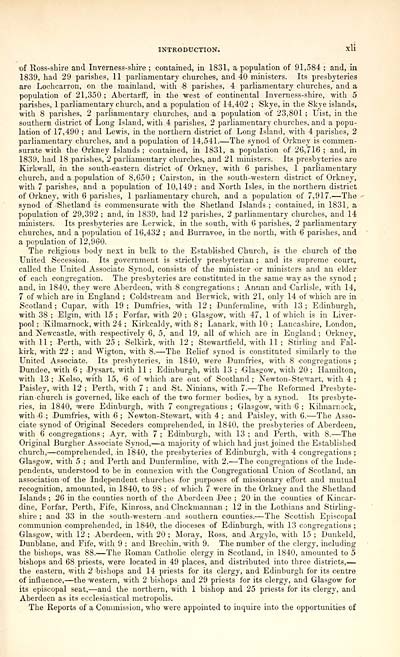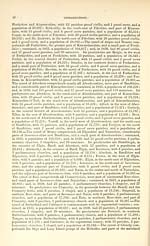Download files
Complete book:
Individual page:
Thumbnail gallery: Grid view | List view

INTRODUCTION.
xli
of Ross-shire and Inverness-shire ; contained, in 1831, a population of 91,584 ; and, in
1839, had 29 parishes, 11 parliamentary churches, and 40 ministers. Its presbyteries
are Lochcarron, on the mainland, with 8 parishes, 4 parliamentary churches, and a
population of 21,350 ; Abertarff, in the west of continental Inverness-shire, with 5
parishes, 1 parliamentary church, and a population of 14,402 ; Skye, in the Skye islands,
with 8 parishes, 2 parliamentary churches, and a population of 23,801 ; Uist, in the
southern district of Long Island, with 4 parishes, 2 parliamentary churches, and a popu-
lation of 17,490 ; and Lewis, in the northern district of Long Island, with 4 parishes, 2
parliamentary churches, and a population of 14,541. — The synod of Orkney is commen-
surate with the Orkney Islands ; contained, in 1831, a population of 26,716 ; and, in
1839, had 18 parishes, 2 parliamentary churches, and 21 ministers. Its presbyteries are
Kirkwall, -in the south-eastern district of Orkney, with 6 parishes, 1 parliamentary
church, and a population of 8,650 ; Cairston, in the south-western district of Orkney,
with 7 parishes, and a population of 10,149 ; and North Isles, in the northern district
of Orkney, with 6 parishes, 1 parliamentary church, and a population of 7,917. — The
synod of Shetland is commensurate with the Shetland Islands ; contained, in 1831, a
population of 29,392 ; and, in 1839, had 12 parishes, 2 parliamentary churches, and 14
ministers. Its presbyteries are Lerwick, in the south, with 6 parishes, 2 parliamentary
churches, and a population of 16,432 ; and JBurravoe, in the north, with 6 parishes, and
a population of 12,960.
The religious body next in bulk to the Established Church, is the church of the
United Secession. Its government is strictly presbyterian ; and its supreme court,
called the United Associate Synod, consists of the minister or ministers and an elder
of each congregation. The presbyteries are constituted in the same way as the synod ;
and, in 1840, they were Aberdeen, with 8 congregations ; Annan and -Carlisle, with 14,
7 of which are in England ; Coldstream and Berwick, with 21, only 14 of which are in
Scotland ; Cupar, with 19 ; Dumfries, with 12 ; Dunfermline, with 13 ; Edinburgh,
with 38 ; Elgin, with 15 ; Forfar, with 20 ; Glasgow, with 47, 1 of which is in Liver-
pool ; Kilmarnock, with 24 ; Kirkcaldy, with 8 ; Lanark, with 10 ; Lancashire, London,
and Newcastle, with respectively 6, 5, and 19, all of which are in England; Orkney,
with 11 ; Perth, with 25 ; Selkirk, with 12 ; Stewartfield, with 11 ; Stirling and Fal-
kirk, with 22 ; and Wigton, with 8. — The Relief synod is constituted similarly to the
United Associate. Its presbyteries, in 1840, were Dumfries, with 8 congregations ;
Dundee, with 6 ; Dysart, with 11 ; Edinburgh, with 13 ; Glasgow, with 20 ; Hamilton,
with 13 ; Kelso, with 15, 6 of which are out of Scotland ; Newton- Stewart, with 4 ;
Paisley, with 12 ; Perth, with 7 ; and St. Ninians, with 7. — The Reformed Presbyte-
rian church is governed, like each of the two former bodies, by a synod. Its presbyte-
ries, in 1840, were Edinburgh, with 7 congregations ; Glasgow, with -6 ; Kilmarnock,
with 6 ; Dumfries, with 6 ; Newton- Stewart, with 4; and Paisley, with 6. — The Asso-
ciate synod of Original Seceders comprehended, in 1840, the presbyteries of Aberdeen,
with 6 congregations-; Ayr, with 7 ; Edinburgh, with 13 ; and Perth, with 8. — The
Original Burgher Associate Synod, — a majority of which had just joined the Established
church, — comprehended, in 1840, the presbyteries of Edinburgh, with 4 congregations ;
Glasgow, with 5 ; and Perth and Dunfermline, with 2. — The congregations of the Inde-
pendents, understood to be in connexion with the Congregational Union of Scotland, an
association of the Independent churches for purposes of missionary effort and mutual
recognition, amounted, in 1840, to 98 ; of which 7 were in the Orkney and the Shetland
Islands ; 26 in the counties north of the Aberdeen Dee ; 20 in the counties of Kincar-
dine, Forfar, Perth, Fife, Kinross, and Clackmannan ; 12 in the Lothians and Stirling-
shire ; and 33 in the south-western and southern counties. — The Scottish Episcopal
communion comprehended, in 1840, the dioceses of Edinburgh, with 13 congregations ;
Glasgow, with 12 ; Aberdeen, with 20 ; Moray, Ross, and Argyle, with 15; Dunkeld,
Dunblane, and Fife, with 9 ; and Brechin, with 9. The number of the clergy, including
the bishops, was 88. — The Roman Catholic clergy in Scotland, in 1840, amounted to 5
bishops and 68 priests, were located in 49 places, and distributed into three districts, —
the eastern, with 2 bishops and 14 priests for its clergy, and Edinburgh for its centre
of influence,— the western, with 2 bishops and 29 priests for its clergy, and Glasgow for
its episcopal seat, — and the northern, with 1 bishop and 25 priests for its clergy, and
Aberdeen as its ecclesiastical metropolis.
The Reports of a Commission, who were appointed to inquire into the opportunities of
xli
of Ross-shire and Inverness-shire ; contained, in 1831, a population of 91,584 ; and, in
1839, had 29 parishes, 11 parliamentary churches, and 40 ministers. Its presbyteries
are Lochcarron, on the mainland, with 8 parishes, 4 parliamentary churches, and a
population of 21,350 ; Abertarff, in the west of continental Inverness-shire, with 5
parishes, 1 parliamentary church, and a population of 14,402 ; Skye, in the Skye islands,
with 8 parishes, 2 parliamentary churches, and a population of 23,801 ; Uist, in the
southern district of Long Island, with 4 parishes, 2 parliamentary churches, and a popu-
lation of 17,490 ; and Lewis, in the northern district of Long Island, with 4 parishes, 2
parliamentary churches, and a population of 14,541. — The synod of Orkney is commen-
surate with the Orkney Islands ; contained, in 1831, a population of 26,716 ; and, in
1839, had 18 parishes, 2 parliamentary churches, and 21 ministers. Its presbyteries are
Kirkwall, -in the south-eastern district of Orkney, with 6 parishes, 1 parliamentary
church, and a population of 8,650 ; Cairston, in the south-western district of Orkney,
with 7 parishes, and a population of 10,149 ; and North Isles, in the northern district
of Orkney, with 6 parishes, 1 parliamentary church, and a population of 7,917. — The
synod of Shetland is commensurate with the Shetland Islands ; contained, in 1831, a
population of 29,392 ; and, in 1839, had 12 parishes, 2 parliamentary churches, and 14
ministers. Its presbyteries are Lerwick, in the south, with 6 parishes, 2 parliamentary
churches, and a population of 16,432 ; and JBurravoe, in the north, with 6 parishes, and
a population of 12,960.
The religious body next in bulk to the Established Church, is the church of the
United Secession. Its government is strictly presbyterian ; and its supreme court,
called the United Associate Synod, consists of the minister or ministers and an elder
of each congregation. The presbyteries are constituted in the same way as the synod ;
and, in 1840, they were Aberdeen, with 8 congregations ; Annan and -Carlisle, with 14,
7 of which are in England ; Coldstream and Berwick, with 21, only 14 of which are in
Scotland ; Cupar, with 19 ; Dumfries, with 12 ; Dunfermline, with 13 ; Edinburgh,
with 38 ; Elgin, with 15 ; Forfar, with 20 ; Glasgow, with 47, 1 of which is in Liver-
pool ; Kilmarnock, with 24 ; Kirkcaldy, with 8 ; Lanark, with 10 ; Lancashire, London,
and Newcastle, with respectively 6, 5, and 19, all of which are in England; Orkney,
with 11 ; Perth, with 25 ; Selkirk, with 12 ; Stewartfield, with 11 ; Stirling and Fal-
kirk, with 22 ; and Wigton, with 8. — The Relief synod is constituted similarly to the
United Associate. Its presbyteries, in 1840, were Dumfries, with 8 congregations ;
Dundee, with 6 ; Dysart, with 11 ; Edinburgh, with 13 ; Glasgow, with 20 ; Hamilton,
with 13 ; Kelso, with 15, 6 of which are out of Scotland ; Newton- Stewart, with 4 ;
Paisley, with 12 ; Perth, with 7 ; and St. Ninians, with 7. — The Reformed Presbyte-
rian church is governed, like each of the two former bodies, by a synod. Its presbyte-
ries, in 1840, were Edinburgh, with 7 congregations ; Glasgow, with -6 ; Kilmarnock,
with 6 ; Dumfries, with 6 ; Newton- Stewart, with 4; and Paisley, with 6. — The Asso-
ciate synod of Original Seceders comprehended, in 1840, the presbyteries of Aberdeen,
with 6 congregations-; Ayr, with 7 ; Edinburgh, with 13 ; and Perth, with 8. — The
Original Burgher Associate Synod, — a majority of which had just joined the Established
church, — comprehended, in 1840, the presbyteries of Edinburgh, with 4 congregations ;
Glasgow, with 5 ; and Perth and Dunfermline, with 2. — The congregations of the Inde-
pendents, understood to be in connexion with the Congregational Union of Scotland, an
association of the Independent churches for purposes of missionary effort and mutual
recognition, amounted, in 1840, to 98 ; of which 7 were in the Orkney and the Shetland
Islands ; 26 in the counties north of the Aberdeen Dee ; 20 in the counties of Kincar-
dine, Forfar, Perth, Fife, Kinross, and Clackmannan ; 12 in the Lothians and Stirling-
shire ; and 33 in the south-western and southern counties. — The Scottish Episcopal
communion comprehended, in 1840, the dioceses of Edinburgh, with 13 congregations ;
Glasgow, with 12 ; Aberdeen, with 20 ; Moray, Ross, and Argyle, with 15; Dunkeld,
Dunblane, and Fife, with 9 ; and Brechin, with 9. The number of the clergy, including
the bishops, was 88. — The Roman Catholic clergy in Scotland, in 1840, amounted to 5
bishops and 68 priests, were located in 49 places, and distributed into three districts, —
the eastern, with 2 bishops and 14 priests for its clergy, and Edinburgh for its centre
of influence,— the western, with 2 bishops and 29 priests for its clergy, and Glasgow for
its episcopal seat, — and the northern, with 1 bishop and 25 priests for its clergy, and
Aberdeen as its ecclesiastical metropolis.
The Reports of a Commission, who were appointed to inquire into the opportunities of
Set display mode to: Large image | Transcription
Images and transcriptions on this page, including medium image downloads, may be used under the Creative Commons Attribution 4.0 International Licence unless otherwise stated. ![]()
| Gazetteers of Scotland, 1803-1901 > Topographical, statistical, and historical gazetteer of Scotland > Volume 1 > (53) Page xli |
|---|
| Permanent URL | https://digital.nls.uk/97438182 |
|---|
| Description | Volume first. A-H. |
|---|---|
| Attribution and copyright: |
|

